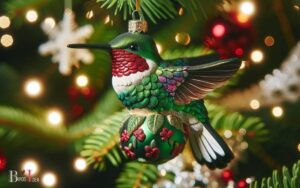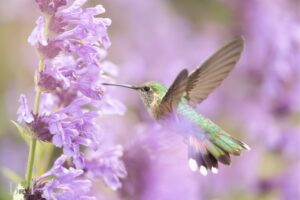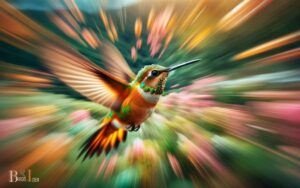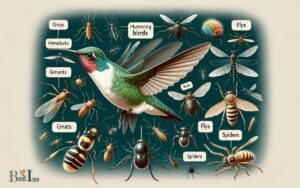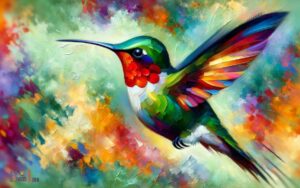Do Ruby Throated Hummingbirds Change Color? No!
Ruby-throated hummingbirds do not change their basic coloration but their feathers can appear differently colored due to iridescence.
This iridescent quality means that the feathers can reflect light in varying colors, giving the impression of changing hues depending on the angle of light and the perspective of the viewer.
Male ruby-throated hummingbirds are especially known for their bright iridescent red throat patch, or gorget, which can look dark or brilliantly ruby-colored in different lights.
The perceived color change in ruby-throated hummingbirds is due to:
For example, a ruby-throated hummingbird may appear to have a black throat in low light but will show a dazzling ruby red when the sunlight hits the throat feathers at the right angle.
Ruby-throated hummingbirds exhibit a dynamic shimmer that enchants onlookers, revealing nature’s palette in motion.
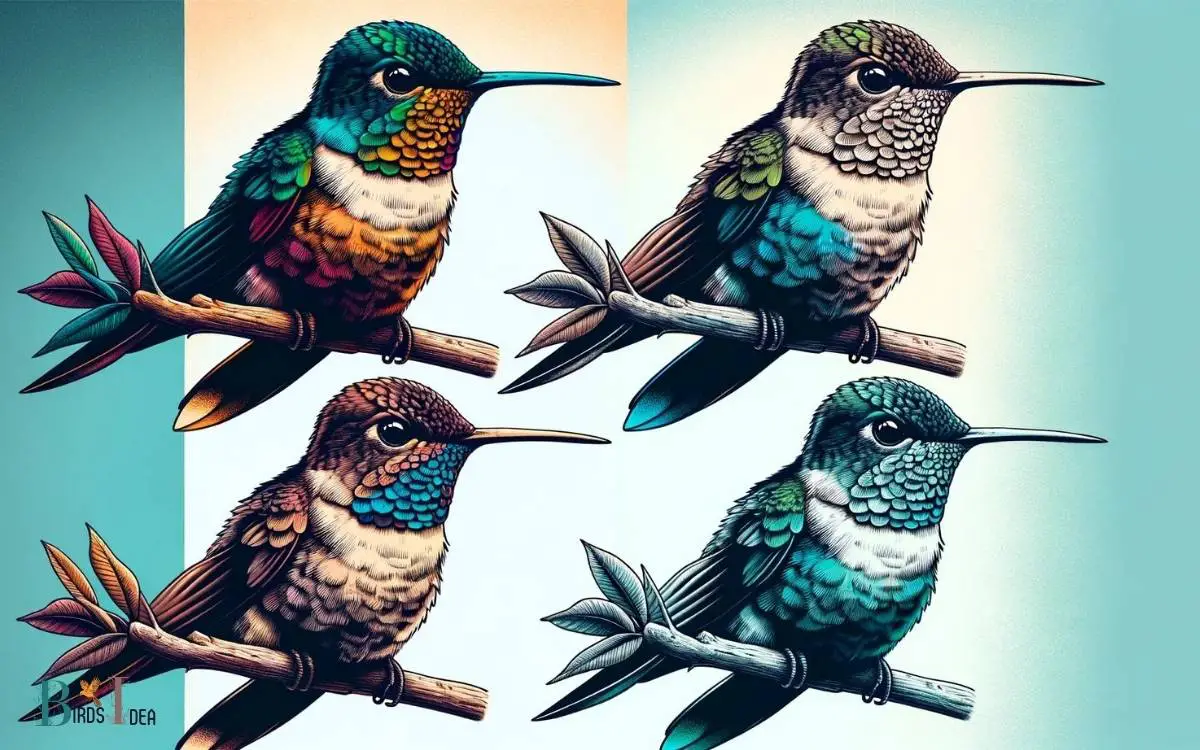
Key Takeaway
5 Factors: Color Variation in Ruby-throated Hummingbirds
| Factor | Description | Influence on Color Perception |
|---|---|---|
| Iridescence | Feather structure that refracts light | Causes color to vary with angle/light |
| Viewing Angle | Position of observer relative to the bird | Alters color visibility |
| Lighting | Intensity and angle of ambient light | Enhances or mutes iridescence |
| Molting | Process of feather replacement | Older feathers may appear less vibrant |
| Health and Diet | General well-being and nutrition | Vibrant colors indicate good health |
The Colorful Plumage of Ruby-Throated Hummingbirds
The colorful plumage of Ruby-Throated Hummingbirds changes with the angle and intensity of light, creating a dazzling display of iridescence. This iridescence is due to the microscopic platelets in the feathers that refract and reflect light, producing a shimmering effect.
The vibrant ruby-red throat patch, or gorget, of the male is particularly striking, appearing black at certain angles and then glowing red when the light hits it just right.
This visual display is integral to courtship and territorial behavior, as the changing colors signal vitality and fitness to potential mates and rivals.
The iridescence of their plumage serves a dual purpose, not only for communication but also for camouflage, as the shifting colors help these small birds blend into their surroundings and evade predators.
Factors Influencing Hummingbird Plumage
Understandably, the iridescence of Ruby-Throated Hummingbird plumage is influenced by a combination of genetic factors and environmental conditions.
Genetic factors determine the baseline coloration and iridescence of the feathers, while environmental conditions such as diet, health, and exposure to sunlight can affect the intensity and vibrancy of the colors.
Additionally, the molting process, where old feathers are replaced by new ones, plays a crucial role in maintaining the hummingbird’s plumage.
The molting cycle is influenced by several factors including hormonal changes, photoperiod, and food availability.
These factors collectively contribute to the stunning and dynamic plumage displayed by Ruby-Throated Hummingbirds.
| Factor | Influence |
|---|---|
| Genetics | Baseline coloration and iridescence |
| Environment | Intensity and vibrancy of colors |
| Molting Process | Maintenance of plumage |
| Hormonal Changes | Timing of molting cycle |
| Photoperiod | Timing of molting cycle |
| Food Availability | Timing of molting cycle |
This understanding provides insights into the delicate balance of factors that shape the plumage of these remarkable birds.
Seasonal Changes in Hummingbird Feathers
In the lifecycle of Ruby-Throated Hummingbirds, seasonal changes in feathers occur as a result of environmental cues and hormonal influences.
During the breeding season, male Ruby-Throated Hummingbirds develop iridescent ruby-red throats, which are used in courtship displays and territory defense.
This coloration is not due to pigments in the feathers but is instead caused by the microscopic structure of the feathers refracting light.
As the breeding season ends and the birds prepare for migration, hormonal changes trigger a molt that replaces the iridescent feathers with duller ones. This molt helps conserve energy during migration and reduces the risk of predation.
Understanding these seasonal changes in hummingbird feathers provides valuable insights into the adaptive strategies of these remarkable birds.
Molt and Its Effect on Hummingbird Coloration
During the molting process, hummingbirds shed and replace their feathers, which can impact their overall coloration. This annual process is crucial for maintaining the structural integrity of the feathers and ensuring efficient flight.
As a result, molt can affect the appearance of hummingbirds, leading to variations in feather color and overall plumage.
Hummingbird Color Change
The molting process in ruby-throated hummingbirds significantly influences their coloration. During molting, old feathers are replaced with new ones, leading to changes in the bird’s appearance.
This process is crucial for maintaining the health and functionality of the hummingbird’s plumage.
The effects of molting on hummingbird coloration can be observed through the following:
- Replacement of Feathers: As old feathers are shed and new ones grow in, the bird’s coloration may appear different due to variations in feather pigmentation.
- Seasonal Changes: Molting can coincide with changes in seasons, impacting the bird’s coloration to better suit its environment or breeding behaviors.
Molt and Feather Color
When undergoing the molting process, ruby-throated hummingbirds experience changes in feather coloration due to the replacement of old feathers with new ones. This molt cycle is essential for maintaining the health and functionality of their plumage.
The new feathers that grow in during molting may exhibit variations in color due to factors such as diet, age, and genetics.
Additionally, the iridescence of the feathers is influenced by the angle of light and the structure of the feather itself.
Understanding the molting process and its effects on feather coloration provides valuable insight into the dynamic nature of hummingbird appearance.
Seasonal Color Variations
Seasonal variations in the coloration of ruby-throated hummingbirds’ feathers are influenced by the molting process, which results in distinct changes in their plumage.
This seasonal molt occurs twice a year, with male hummingbirds typically molting in late summer after the breeding season and again in early spring before migration.
During the molt, old feathers are shed and replaced with new ones, leading to changes in coloration.
The vibrant iridescent feathers of the males play a crucial role in courtship displays and territorial defense, making the seasonal color variations an essential aspect of their reproductive behavior.
Additionally, the molting process allows for the removal of damaged feathers, ensuring that the hummingbirds maintain their aerodynamic capabilities for efficient flight.
Diet and Pigment Variation in Hummingbirds
Diet plays a crucial role in the coloration of hummingbirds, as it directly affects the availability of pigments that contribute to their vibrant plumage.
Research has shown that the pigments in hummingbird feathers can change based on the specific diet of the bird, leading to variations in coloration.
Understanding the link between diet and pigment variation is essential in comprehending the mechanisms behind the stunning array of colors observed in hummingbirds.
Diet Affects Coloration
The coloration of Ruby Throated Hummingbirds is influenced by their dietary intake, leading to variations in pigmentation. The specific pigments responsible for the vibrant colors of hummingbird feathers are obtained from their diet.
Natural Diet Variation:
- Hummingbirds consuming nectar from flowers with high levels of carotenoids tend to exhibit more intense red and orange plumage.
- Those feeding on insects rich in melanin may develop darker and more iridescent feathers.
Dietary intake plays a crucial role in determining the availability of pigments for feather coloration in hummingbirds.
This intricate relationship between diet and pigmentation highlights the importance of environmental factors in shaping the visual characteristics of these remarkable birds.
Pigment Changes With Diet
Hummingbirds’ plumage coloration undergoes variation based on their dietary pigment intake, reflecting the influence of diet on their visual characteristics.
The pigments responsible for the coloration of hummingbird feathers are derived from their diet, specifically from the pigmented compounds present in the nectar, insects, and other food sources they consume.
For example, carotenoid pigments obtained from flower nectar are responsible for the red, orange, and yellow colors observed in hummingbird feathers.
Additionally, the availability of specific pigments in their diet can influence the vibrancy and intensity of their plumage coloration.
Therefore, variations in the availability and intake of pigmented compounds from dietary sources can lead to observable changes in the coloration of hummingbird feathers,
Highlighting the intricate relationship between diet and pigment variation in these remarkable birds.
Color Linked to Diet
Linked to their dietary intake of pigmented compounds, the coloration of hummingbird feathers serves as a visual reflection of the influence of their diet on their plumage.
The specific pigments present in their food sources directly impact the colors of their feathers, resulting in a fascinating array of hues and patterns.
This intricate relationship between diet and plumage coloration can be observed through the following:
- Carotenoid-rich Diet: Hummingbirds consuming a diet rich in carotenoids exhibit vibrant red, orange, and yellow plumage, indicating their intake of these pigments from sources such as nectar and pollen.
- Anthocyanin-rich Diet: Alternatively, a diet abundant in anthocyanins leads to the development of deep purples, blues, and iridescent greens in the feathers, showcasing the direct influence of these pigments on the birds’ coloration.
Genetics and Coloration in Ruby-Throated Hummingbirds
In the study of genetics and coloration in Ruby-Throated Hummingbirds, understanding the mechanisms behind their vibrant plumage requires careful examination of their genetic makeup and physiological processes.
The coloration of Ruby-Throated Hummingbirds is influenced by a combination of genetic factors and environmental conditions.
The presence of specific pigments, such as melanin and carotenoids, plays a crucial role in determining the coloration of their feathers.
Additionally, the genetic expression of these pigments is influenced by various environmental factors, such as diet and habitat.
Understanding the genetic basis of coloration in these hummingbirds provides valuable insights into their evolutionary history and ecological adaptations.
| Genetic Factors | Environmental Factors |
|---|---|
| Melanin presence | Diet |
| Carotenoid levels | Habitat |
| Genetic expression | Climate |
| Plumage patterns | UV exposure |
| Color inheritance | Seasonal variations |
Environmental Impacts on Hummingbird Colors
The study of genetics and coloration in Ruby-Throated Hummingbirds has highlighted the significant influence of environmental factors on their vibrant plumage.
Environmental impacts on hummingbird colors can be observed through:
- Diet: Hummingbirds derive pigments from their diet, and variations in available floral nectar can influence the intensity of their plumage colors. For instance, a diet rich in anthocyanin pigments from certain flowers can result in more vivid red throat patches.
- Sunlight: Exposure to sunlight affects the perception of hummingbird colors. Sunlight can enhance the iridescence of their feathers, causing them to appear more brilliant and colorful to potential mates and rivals.
These factors underscore the dynamic relationship between the environment and the striking colors of Ruby-Throated Hummingbirds.
Predation and Camouflage in Hummingbirds
Environmental influences on hummingbird colors are further evident in their adaptation for predation avoidance through camouflage.
Hummingbirds have evolved various colorations and patterns to blend into their surroundings, making them less conspicuous to potential predators.
This adaptation helps them to hide from threats and increases their chances of survival in the wild.
The following table illustrates some examples of hummingbird species and their corresponding camouflage strategies:
| Hummingbird Species | Camouflage Strategy |
|---|---|
| Ruby-throated | Green back and white underside for blending with foliage |
| Buff-bellied | Speckled throat and underparts for blending with dappled light |
| White-throated | Mottled brown and white plumage for blending with tree bark |
| Buff-winged | Brown and buff coloration for blending with dry leaves |
| Black-chinned | Iridescent green throat for blending with flowers |
These examples demonstrate the diverse ways in which hummingbirds have adapted their colors and patterns to evade predators in their natural habitats.
Human Interactions and Hummingbird Color Perception
Adapting to their natural environments through camouflage, hummingbirds have also captured human interest with their vibrant colors and iridescent plumage.
When humans interact with these tiny birds, they perceive a striking array of colors due to the unique physiology of hummingbirds and the way light interacts with their feathers.
This perception is enhanced by the following factors:
- Visual acuity: Hummingbirds have excellent color vision, allowing them to perceive a wide spectrum of colors, including ultraviolet light, which is invisible to humans.
- Attraction to specific colors: Hummingbirds are often attracted to red, orange, and pink colors, which are associated with nectar-producing flowers.
Understanding these aspects of human interactions and hummingbird color perception enhances our appreciation for these remarkable creatures.
Conclusion
The coloration of ruby-throated hummingbirds is influenced by a variety of factors including genetics, diet, molt, and environmental impacts.
These tiny birds undergo seasonal changes in their feathers, and their vibrant plumage serves multiple purposes, including predator avoidance and mate attraction.
The intricate interplay of genetic, environmental, and behavioral factors contributes to the stunning array of colors seen in these remarkable creatures.
How might human interactions with hummingbirds continue to shape our understanding of their color perception and adaptation?

